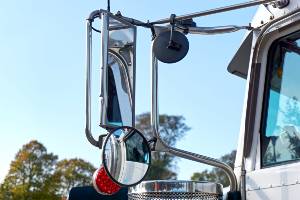 One of the dangers of sharing the road with commercial trucks is they have large blind spots in front, behind, and on both sides. While the drivers of these vehicles need to be cautious about changing lanes to avoid blind-spot crashes, it is also a good idea to avoid driving in blind spots when possible.
One of the dangers of sharing the road with commercial trucks is they have large blind spots in front, behind, and on both sides. While the drivers of these vehicles need to be cautious about changing lanes to avoid blind-spot crashes, it is also a good idea to avoid driving in blind spots when possible.
Since there are steps both commercial truck drivers and others sharing the road can take to prevent a blind-spot crash, you may have questions about fault for these accidents.
Could the victim be found partially responsible for a blind-spot crash with a commercial truck? If so, how much responsibility could the victim bear?
Below, we discuss commercial truck blind spots in detail and what you need to know about fault for these collisions. Before discussing fault, your injuries or other details about the crash with the insurance company, you should strongly consider speaking to a licensed attorney.
At Schmidt Kramer, the initial consultation is free of charge and there is no obligation to take legal action.
Where Are a Commercial Truck Driver’s Blind Spots?
There are certain spots around a commercial truck where the driver cannot see your vehicle. This includes:
- Within 20 feet of the front of the truck
- Anywhere behind the driver’s door in the lane to the left of the truck
- Within 30 feet of the trailer
- Anywhere within two lanes of the right side of the cab and trailer
These areas are called no zones, which means you should always try to avoid them. If you find yourself in a blind spot, change lanes, slow down, or speed up (without exceeding the posted limit), to get to a place where the truck driver can see you.
Why Blind-Spot Crashes with Commercial Trucks May Happen
Commercial truck blind spot crashes often happen when the truck driver attempts to change lanes or merge. Passenger vehicles could get sideswiped or simply run over, as commercial trucks are so much larger than passenger vehicles.
If a truck starts coming over into your lane and you cannot slow down to avoid a crash, you might swerve or move into the lane to the right or left of yours. However, this could easily result in a collision with another vehicle. In some situations, drivers may swerve into lanes of oncoming traffic. This could result in a deadly head-on collision.
If a truck driver tailgates another vehicle, he or she probably cannot see it. This could result in a rear-end crash that could cause severe injuries.
Evaluating Fault for These Crashes
It is important to note many commercial truck crashes, including blind-spot crashes, are a result of the truck driver’s negligence. For example, blind-spot crashes could occur because a truck driver was:
- Distracted
- Under the influence of drugs or alcohol
- Tired
- Negligent in watching for surrounding traffic
- Negligent in using a turn signal and waiting for traffic to clear
- Negligent in checking blind spots
- Negligent in aligning mirrors to give him or her a better view around the truck
- Driving a truck without the appropriate mirrors
- Not properly trained or lacked the qualifications to be driving the vehicle
Trucking companies or those involved in repairing these vehicles could also be partially at fault for failing to repair or install the appropriate mirrors. The truck driver’s employer could also bear fault for allowing him or her to drive without the proper qualifications.
Product manufacturers, such as the manufacturer of a crash avoidance system or blind-spot warning system, could also have liability.
Could the Victim Be Partially at Fault?
It may be difficult to assign partial fault to a victim. Even though you may be able to move from a truck’s blind spot, and you should try to whenever possible, the truck driver needs to be cautious about changing lanes.
There are times when it is impossible to get out of a truck driver’s blind spots. For example, in heavy traffic, changing lanes may be impossible.
The main thing to remember is the truck driver has a responsibility to others on the road to operate his or her vehicle safely. He or she needs to use his or her mirrors or other available technology to help prevent a crash.
How Insurers View Fault for These Crashes
Despite the fact truck drivers need to be cautious about avoiding blind-spot crashes, insurance companies have their own way of analyzing fault for these crashes. For example, they may say you are at fault for the crash because:
- You were the one driving in a blind spot
- You could have sped up or slowed down so the driver could see you
- You should have been more cautious; truck drivers have a lot to be concerned with and cannot always keep track of cars in their blind spots
Insurers may sound sure of themselves when they make these kinds of statements. However, these statements are unlikely to hold up under scrutiny, particularly if the victim of the crash is being represented by an experienced Harrisburg truck accident attorney.
Contact Schmidt Kramer to Discuss Your Legal Options
Unsure about your legal options? Have questions about what the insurance company told you after the crash?
During this stressful time, it is important to seek help from an experienced attorney. At Schmidt Kramer, we have been helping motor vehicle crash victims for decades and have secured millions on their behalf. There are no upfront fees or obligations with our services, and we do not get paid unless our clients get paid.
Give us a call today to learn more. Phone: (717) 727-2089.

